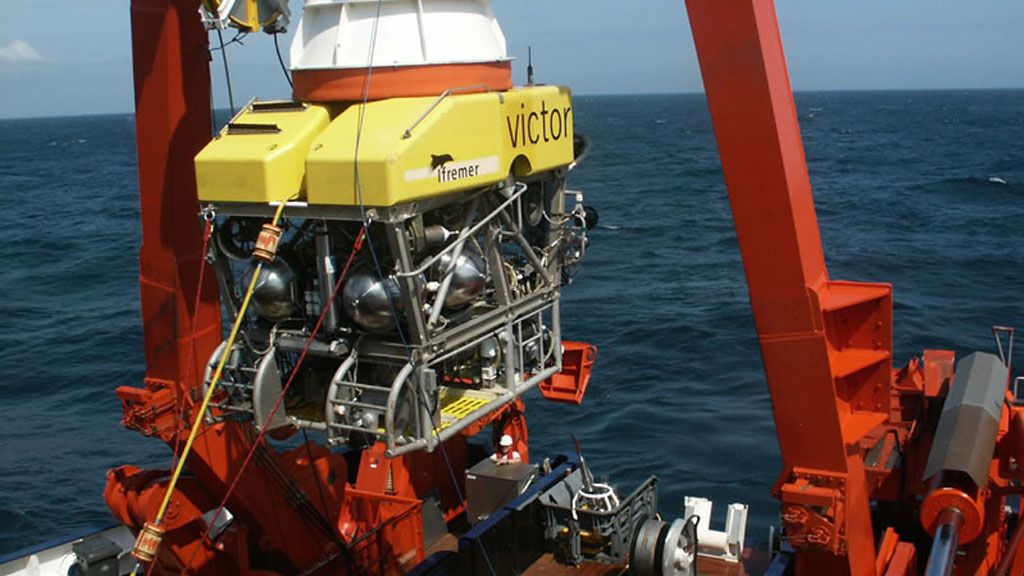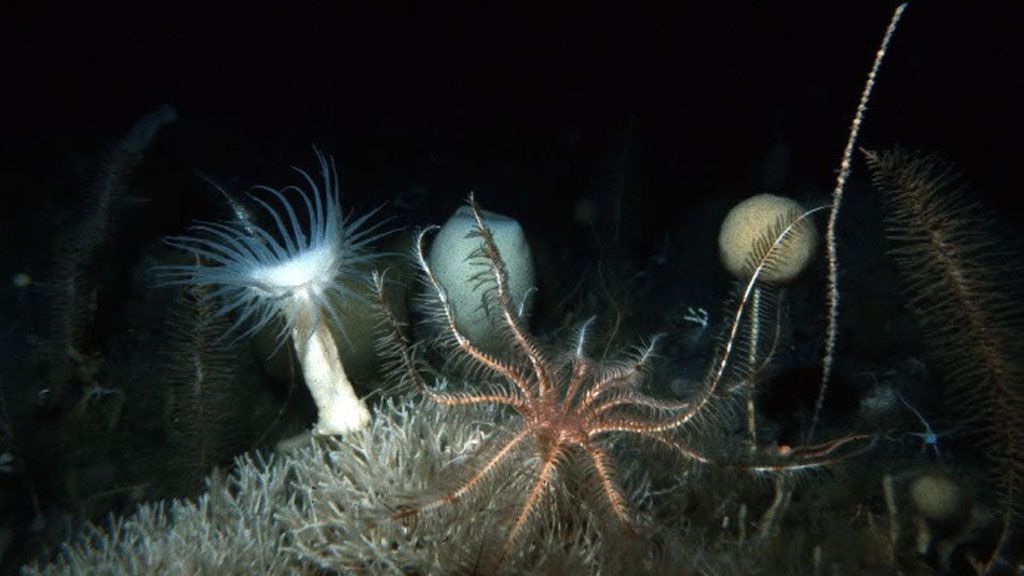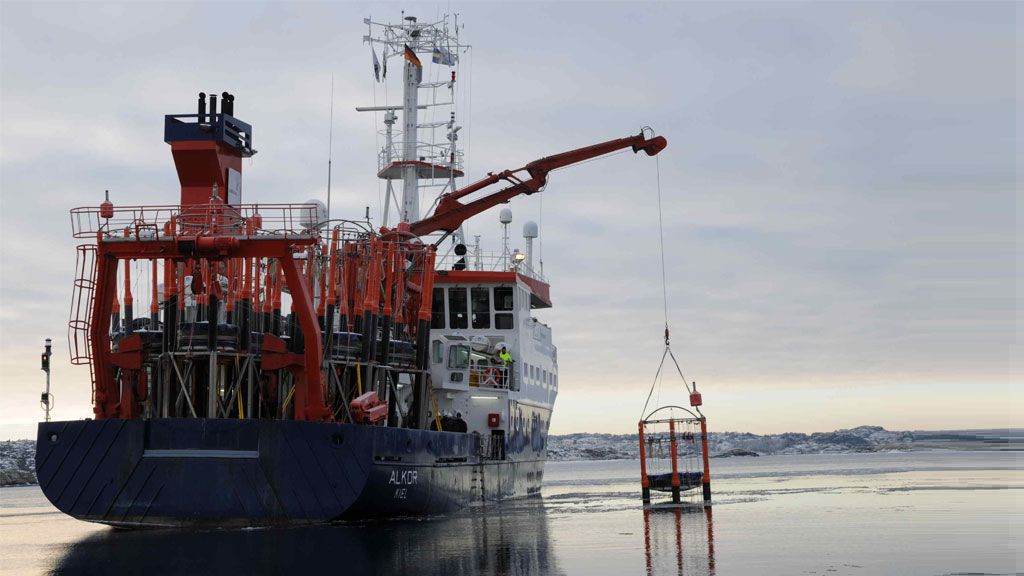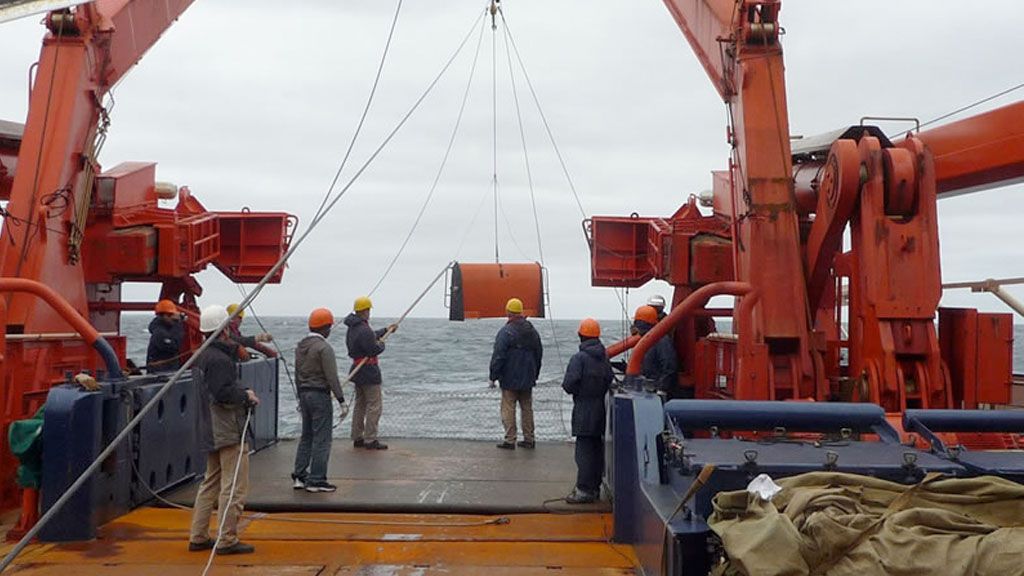UN Convention on Biological Diversity Secretariat speaks about ocean acidification
The VICTOR ROV (Remotely Operated Vehicle)
© NOAA
Like tropical coral reefs, polar and sub-polar coral reefs play an important role in absorbing carbon dioxide from the atmosphere. However as these coral reefs start to dissolve as a result of increasing ocean acidification, entire marine ecosystems are put at risk, as is the ocean’s ability to absorb carbon dioxide.
The world’s oceans are a natural sink for carbon dioxide, both organically and inorganically.
- Organically, primary producers such as phytoplankton present in the oceans absorb carbon from the atmosphere, fixating it in their bodies as they grow and reproduce, and relegating it to the bottom of the ocean once they die.
- Inorganically, carbon dioxide from the atmosphere is absorbed into oceanic waters, given that carbon dioxide is soluble in water.
Whenever carbon dioxide is dissolved directly into water, it creates carbonic acid (H2CO3), which makes the ocean less alkaline (ocean water is naturally slightly alkaline, with current pH of about 8.1, and a pH of 7 being neutral on the logarithmic scale). Thus, the more anthropogenic carbon dioxide increases in the atmosphere, the more carbon dioxide is absorbed into the ocean, and the more acidic the oceans become. This process of ocean acidification has many consequences for marine ecosystems, especially shellfish and coral reefs, whose exoskeletons are made of calcium carbonate (CaCO3), a substance that dissolves in acidic conditions.
While most people associate coral reefs with tropical waters, there are numerous cold-water reefs in polar and sub-polar regions of the planet, including several off the coast of Norway and Iceland, and some in the Southern Ocean. Like tropical coral reefs, polar and sub-polar coral reefs play an important role in marine ecosystems, providing shelter and food to a wide variety of animals, serving as nurseries for various species of fish, acting as a source of a large number of natural medicines, and playing an important role in absorbing carbon dioxide from the atmosphere. However as these coral reefs start to dissolve as a result of increasing ocean acidification, entire marine ecosystems are put at risk, as is the ocean’s ability to absorb carbon dioxide.
According to the report, seas and oceans absorb approximately one quarter of carbon dioxide emitted to the atmosphere from the burning of fossil fuels, and ocean acidity will increase by 150% by 2050. How was this figure derived?
As outlined in the report, the absorption of CO2 by the oceans (the underlying cause of ocean acidification) follows well-known and proven chemical and thermodynamic reactions. As such, the consequence of rising atmospheric CO2 (e.g. on the basis of the various IPCC scenarios) and the changes in ocean chemistry can be calculated / predicted with a high level of certainty. Absorption of anthropogenic CO2, reduced pH, and lower calcium carbonate saturation in surface waters, are well verified from models, hydrographic surveys and time series data (see Doney, 2009).
The report also states that this increase in ocean acidification is 100 times faster than any change in acidity experienced in the marine environment over the last 20 million years. How do we know this? Where and with what tools are paleo-climatologists able to read past ocean acidity levels and fluctuations over millions of years?
Global atmospheric CO2 concentration and temperature data from the Vostok Ice Core was used in one study to explore the ocean temperature and carbonate ion concentration seen today relative to the recent past for a typical low latitude sea (Hoegh Guldberg et al, 2009). As suggested in the report on p22, studying the fossil record for benthic calcified organisms for notable gaps and relating this to the atmospheric concentration during that period can also provide data. Proxy estimates based on boron isotopes have been used in some studies to suggest previous ocean pH (see Royal Society, 2005).
Is ocean acidification in any way linked to mean oceanic temperature?
Colder waters, due to their higher solubility for CO2, naturally hold more CO2 and are more acidic than warmer waters. However, other biological, chemical and physical factors such as carbonate chemistry and biological productivity influence the uptake of CO2 and result in a variable mixed surface layer pH and magnitude of ocean acidification across the global oceans.
Is CO2 the only atmospheric gas with an effect on ocean acidification? What about other greenhouse gasses like methane?
Ocean acidification is defined in the scientific literature as ‘the addition of carbon dioxide in seawater that causes a reduction in ocean pH and shifts in carbonate speciation’. Increasing ocean acidification follows, albeit with a time lag, the accelerating trend in world CO2 emissions. Other greenhouse gases have an indirect effect on ocean acidification, e.g. by increasing the water temperature of particular regions or water bodies, which then affects the solubility of CO2 (see questions 3 and 5 above).
Why is ocean acidification more pronounced in the Arctic and Antarctic (Southern Ocean)?
Colder waters, due to their higher solubility for CO2, naturally hold more CO2 and are more acidic than warmer waters. As such, it is suggested that with increasing atmospheric CO2 concentrations, the surface waters of high latitude oceans will be the first to become under-saturated with respect to calcium carbonate. Models have indicated that the cold Southern Ocean is particularly vulnerable given the low existing saturation levels of carbonate minerals, uniform temperatures and the extent of mixing in the water column.
What are the effects of ocean acidification on coral?
The response of tropical coral reefs to ocean acidification will range from the point where reduced skeletal growth affects the coral’s ability to survive, to the point where a reef loses the ability to maintain its structure. These thresholds will vary from coral to coral and reef to reef. Reefs in acidified waters are predicted to decline in the following sequence:
- loss of coralline algae causing decreased reef consolidation,
- loss of carbonate production by corals resulting in loss of habitat,
- loss of biodiversity with extinctions.
The failure of coral communities to compete with algal communities that will not be similarly affected by ocean acidification could result in an ecological phase shift to a new stable ecosystem state dominated by less commercially valuable species. It should be noted that in the eastern tropical Pacific (ETP), surface waters have lower pH, lower carbonate saturation and higher pCO2 values relative to other tropical marine areas. Reefs in the ETP area are poorly cemented and not as strong and massive as their counterparts in other areas (see report p26).
The effects of ocean acidification on cold water coral communities are similar to that of tropical corals in terms of increased energy needed to produce skeletal structures, causing reduced growth and weakening of the corals. Cold water corals are usually found in larger depths and total darkness, i.e. beyond the area where light penetrates the ocean and allows algae to grow. Replacement of cold-water coral with algal communities is therefore not an issue.
However, ecological phase shifts might still happen, whereby the cold water coral communities are replaced by other, less diverse systems which are not or less affected by ocean acidification. Current predictions estimate that around 70% of all known cold water coral ecosystems could experience cold-water corrosive water conditions by the end of the century, although some may experience aragonite under-saturation as early as 2020 (see report p39)
What about the effects of ocean acidification on shell fish? Would it be possible for these species just migrate to less acidic waters?
As highlighted in the report, biological responses to ocean acidification especially in calcifying organisms will be species specific and varied with some species able to adapt and proliferate, while many others are no longer viable. Recent studies suggest that the calcification rates, growth rates, size and body weights of species of shellfish can be affected by exposure to low pH, which has long term implications for organism health. Exposure will depend on the energetic costs to maintain adaptive physiological mechanisms.
Lower marine invertebrates are characterized by a low capacity to compensate for disturbances in extracellular ion and acid base status and sensitivity of metabolism to such disturbances. Available data suggest that one key consequence of these features will be a narrowing of thermal tolerance windows, which could have implications for the geographical distribution of sensitive organisms (see Hans-O Pörtner, 2008). It should also be noted that ocean acidification will affect in the first instance the most vulnerable life stages or phases of a particular species. Many shellfish species which live on the seafloor as adults have pelagic larvae and such larvae are often more sensitive to ocean chemistry changes. Also, 'migration to less acidic waters' might simply not be possible for species which rely on ocean currents for their larval distribution.
What would be the effect of a shell fish collapse on the food web as a whole? How does this work?
Mussel beds provide food and structure for a diverse array of species. Many calcifying species are located at the bottom or middle of global ocean food webs. Therefore the loss of shelled organisms to ocean acidification will alter the predator-prey relationships and the effects will be transmitted throughout the ecosystem.
Figure 15, p49 of the report demonstrates the complex interconnections in global marine food webs that are at risk from ocean acidification.
How long could it take for an effected ocean ecosystem to repair itself or for pH to return to a level more suitable for shellfish?
Ocean acidification is irreversible on short term timeframes of at least tens of thousands of years, and is determined in the longer term by physical mixing processes within the ocean that allow ocean sediments to buffer the changes in ocean chemistry.
Will the ocean acidification problem eventually need to be solved through geo-engineering methods such as iron fertilization? Is it realistically possible to solve the problem this way?
The addition of vast amounts of alkaline compounds to seawater such as calcium hydroxide or magnesium hydroxide has been suggested as a mechanism to reduce atmospheric CO2 while mitigating ocean acidification. However, uncertainties exist surrounding the efficiency of this method to effect significant changes in ocean acidification, and in regards to the localized effects on the marine ecosystem.
Furthermore, ocean fertilization, which is any activity undertaken by humans with the principal intention of stimulating primary productivity in the oceans to induce a biologically mediated CO2 uptake from the atmosphere, bears a high risk of changing ocean chemistry and pH, especially if carried out repeatedly and at a large scale. The impacts of ocean fertilization on marine biodiversity have been synthesized in a separate CBD Technical Series #45.

UN Convention on Biological Diversity Secretariat
The Convention on Biological Diversity (CBD) entered into force on 29 December 1993. It has 3 main objectives:
- The conservation of biological diversity
- The sustainable use of the components of biological diversity
- The fair and equitable sharing of the benefits arising out of the utilization of genetic resources





